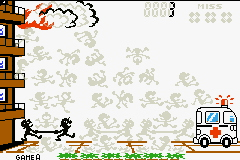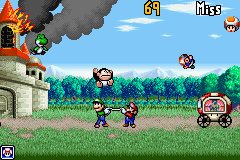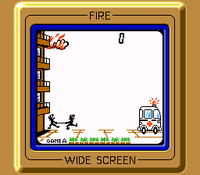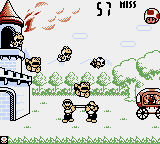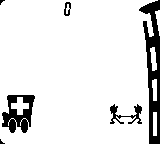Fire (Game & Watch): Difference between revisions
Bowserbros (talk | contribs) No edit summary |
|||
| Line 2: | Line 2: | ||
{{distinguish|Fire Attack}} | {{distinguish|Fire Attack}} | ||
{{multiframe|[[File:Game&Watch-Fire.gif]] [[File:Fire GW4.PNG]]|''Fire''{{'}}s Classic version (top) and Modern version (bottom) in ''Game & Watch Gallery 4''|size=240|align=right}} | {{multiframe|[[File:Game&Watch-Fire.gif]] [[File:Fire GW4.PNG]]|''Fire''{{'}}s Classic version (top) and Modern version (bottom) in ''Game & Watch Gallery 4''|size=240|align=right}} | ||
'''''{{wp|List of Game & Watch games#Fire|Fire}}''''' is a [[Game & Watch]] game released as part of the Silver series on July 31, 1980, and later as part of the Wide Screen series on December 4, 1981. There are remakes of it in three games of the [[Super Mario (franchise)|''Super Mario'' franchise]]: ''[[Game & Watch Gallery]]'', ''[[Game & Watch Gallery 3]]'', and ''[[Game & Watch Gallery 4]]''. | '''''{{wp|List of Game & Watch games#Fire|Fire}}''''' (originally released in North America as '''''Fireman Fireman'''''<ref>{{cite|author=Phil Salvador|date=June 13, 2024|url=https://gamehistory.org/mego-time-out-commercial/|title=Is this the first Nintendo commercial?|publisher=Video Game History Foundation|archive=https://web.archive.org/web/20240627061609/https://gamehistory.org/mego-time-out-commercial/|accessdate=July 2, 2024}}</ref>) is a [[Game & Watch]] game released as part of the Silver series on July 31, 1980, and later as part of the Wide Screen series on December 4, 1981. There are remakes of it in three games of the [[Super Mario (franchise)|''Super Mario'' franchise]]: ''[[Game & Watch Gallery]]'', ''[[Game & Watch Gallery 3]]'', and ''[[Game & Watch Gallery 4]]''. | ||
==Gameplay== | ==Gameplay== | ||
Revision as of 18:29, July 2, 2024
- Not to be confused with Fire Attack.
Fire (originally released in North America as Fireman Fireman[1]) is a Game & Watch game released as part of the Silver series on July 31, 1980, and later as part of the Wide Screen series on December 4, 1981. There are remakes of it in three games of the Super Mario franchise: Game & Watch Gallery, Game & Watch Gallery 3, and Game & Watch Gallery 4.
Gameplay
Classic version
People jump out of a burning building and fall down to get rescued. The player, controlling two men carrying a life net, must bounce the people off the life net to get them to the ambulance on the other side of the screen. If the two men catch a person, the player earns a point; people who have been caught bounce and must be caught again. People fall at different speeds depending on where they are. As time passes, more people jump from the burning building, and they eventually fall faster. If the two men miss one of the falling people, the person gets injured and runs away, and the player receives a miss. If the player reaches 200 and 500 points, any misses they have are removed, and the people freeze to make it easy to get them before they continue falling. The player receives a Game Over when they have three misses. In Game B, people jump out from two floors of the burning building, making the game harder.
Modern version
Mario and Luigi attempt to catch Toads, Yoshis, and Donkey Kong Jrs. after they jump out the window of Princess Peach's burning castle. The catch is that different characters fall at different speeds: Toads bounce the highest, while Donkey Kong Jrs. bounce the lowest. Yoshi Eggs also appear and contain either a Bob-omb or a Moon (a Super Star in the first game); the eggs break open when they are caught or hit the ground. The player receives two points for catching an egg. If a Bob-omb reaches the carriage, everyone, including the Mario Bros., runs away as the carriage explodes, and the player gets a miss. If the Mario Bros. catch a Moon, the player receives five points. At 200, 500, and 700 points, Peach appears and blows a kiss, sending out a heart for Mario or Luigi to catch to remove a miss. Music is also featured in this version, with the tempo changing depending on the speed of the game. In the Game & Watch Gallery 4 version, the time of day changes every 200 points collected.
If the player selects this game in Game & Watch Gallery 4 yet does not start playing it, a humorous sequence plays. In particular, Mario and Luigi catch a Toad sent flying to the left and a Yoshi sent flying to the right, only to narrowly stop when discovering their next "rescue" was in fact a Bob-omb, which detonates inches from them, and are then forced to flee as a dozen Bob-ombs are raining from the sky.
Controls
Game & Watch Gallery
(left and right): Move
: Move left
: Move right
Game & Watch Gallery 4
 : Move
: Move : Move left
: Move left : Move right
: Move right
Gallery
Modern version
Game & Watch Gallery
Game & Watch Gallery 4
Trivia
- In the original Silver and Wide Screen versions, angels were used as miss marks. In the Game & Watch Gallery series, bandages replaced the angels. An animation was also added to show the evacuee limping away.
- The port shown in Game & Watch Gallery 3 is reversed. According to the game, Fire was originally supposed to ship as such, but a mistake was made during LCD production and the graphics were reversed.
- The Game & Watch Gallery 3 port of Fire uses the design of the original Silver series Fire with the points system of the Wide Screen series Fire. In the original Silver version of Fire, points were given only when an evacuee would reach the ambulance.
- In Game & Watch Gallery 4's Modern version of Fire, a Para Troopa occasionally appears in the background during the day, while an albatross occasionally does so at sunset.
- The Game & Watch Gallery 4 Modern version of Fire was apparently meant to be one of the games included in the canceled Game & Watch series of e-Reader cards.
External links
- The original Silver version of Fire info page on In the Attic, a website dedicated to classic videogames (Internet Archive: Wayback Machine)
- The Wide Screen rerelease of Fire on In the Attic (Internet Archive: Wayback Machine)
| Game & Watch Gallery series | ||
|---|---|---|
| Games | Game & Watch Gallery (1997, GB) • Game & Watch Gallery 2 (1997, GB) • Game & Watch Gallery 3 (1999, GBC) • Game & Watch Gallery 4 (2002, GBA) | |
| Super Mario minigames | Donkey Kong2,4 • Donkey Kong Jr.3,4 • Donkey Kong II3 • Donkey Kong 34 • Mario Bros.3,4 • Mario's Bombs Away4 • Mario's Cement Factory4 | |
| Minigames remade with Super Mario content |
Ball2 • Boxing4 • Chef2,4 • Egg3 • Fire1,4 • Fire Attack4 • Greenhouse3 • Helmet2 • Manhole1 • Octopus1,4 • Oil Panic1 • Parachute2 • Rain Shower4 • Turtle Bridge3 • Vermin2 | |
| Gallery Corner | Message Board • Museum • Music Room | |
| Further info | Gallery (2 · 4) • Pre-release and unused content (4) • Staff (2 · 3 · 4) | |
| Related game | Game & Watch Collection | |
- ^ Phil Salvador (June 13, 2024). Is this the first Nintendo commercial?. Video Game History Foundation. Retrieved July 2, 2024. (Archived June 27, 2024, 06:16:09 UTC via Wayback Machine.)
